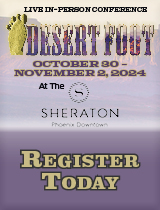Query: Granuloma Excision – Nail Avulsion
I recently saw a patient who presented a
neglected ingrown toenail with proud flesh and
granuloma. After administration of local
anesthesia, I performed a partial nail avulsion,
excised the fleshy border, and followed with
application of silver nitrate to the granuloma
base. I am considering coding the procedures as:
CPT 11730 (partial nail avulsion) and CPT 17250
(chemical cauterization of granulation, tissue
[proud flesh, sinus or fistula]
I cannot find CPT 17250 in the CCI edits for CPT
11730, so should I expect payment?
Since both are performed on the same toe, should
I use a "-51" modifier or "-59" modifier anyway?
I think "-51" is more appropriate in this case.
I would be linking ICD-9 681.11 (paronychia) and
ICD-9 686.1 (granuloma) to the procedure codes.
I saved the fleshy border specimen in
formaldehyde, and will send it to pathology, if
needed, to justify my reimbursement, as well as
cover myself and the patient.
Mark Sturge, DPM
Miami, FL
Codingline Response: You cannot separately bill
for both the nail avulsion (CPT 11730) and the
chemical cauterization of granuloma (CPT 17250)
performed on the same toe, same session.
The CPT parenthetical rule following the CPT
17250 listing states,
“17250 is not to be used with removal or
excision codes for the same lesion”
Plus, the Correct Coding Initiative (CCI) DOES
link and bundle these two codes together with
CPT 17250 being a component of the comprehensive
code, CPT 11730. While they can technically
be “unbundled” with a “-59” modifier,
again, “same toe, same session” procedures such
as these would normally be considered
reimbursable as a single code, CPT 11730.
As far as the need to send in a path specimen,
your primary reason for obtaining the specimen
and submitting it for study must be for
medically necessary determination/confirmation
of tissue type when any uncertainty exists. If
your primary reason for obtaining and submitting
a specimen is concern over evidencing tissue
removal for an insurance company, you may want
to think about taking close-up [patient
identified, dated, and measured] digital photos
of the specimen in situ and post-op.
Once the initial investment is made in a good
digital camera, there are hardly any ongoing
costs. If a question arises from an insurance
company, the photo is usually sufficient to
warrant its weight in “reimbursement” – whether
it helps evidence a code to be an independently
reimbursable procedure, or whether it helps
support reimbursement of a more comprehensive
procedure, or whether it serves as a visual
validation of clinical findings in the
submission of a claim for either an unlisted
procedure code or a “-22” modified code. Of
course, as a clinician, if you need the
information, a path report can be included to
confirm your suspicions and allow you to treat
in a more effective fashion, and then submit the
specimen at conclusion of the case.
Harry Goldsmith, DPM
Cerritos, CA







